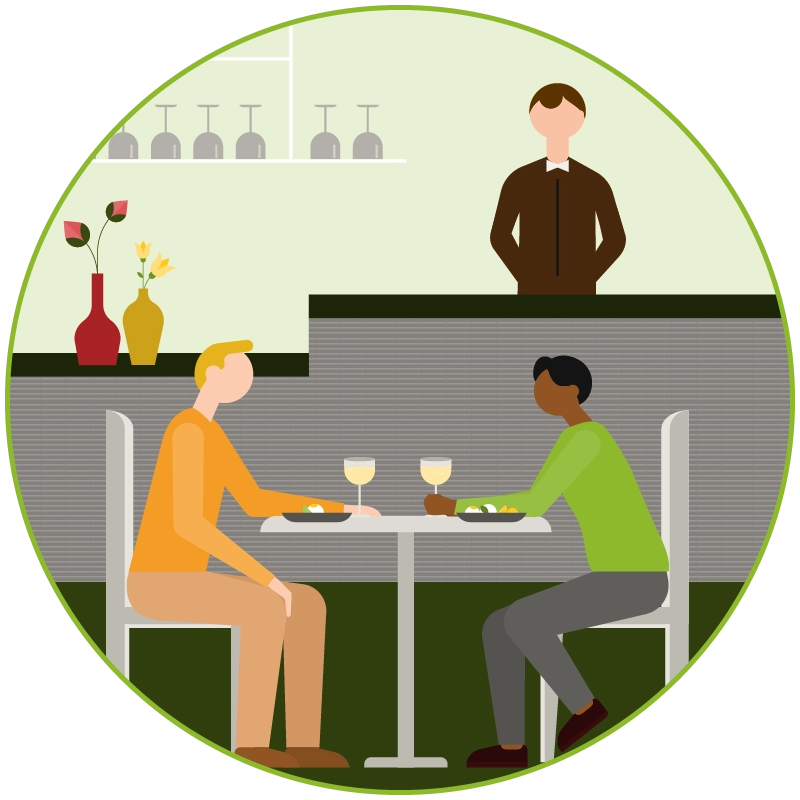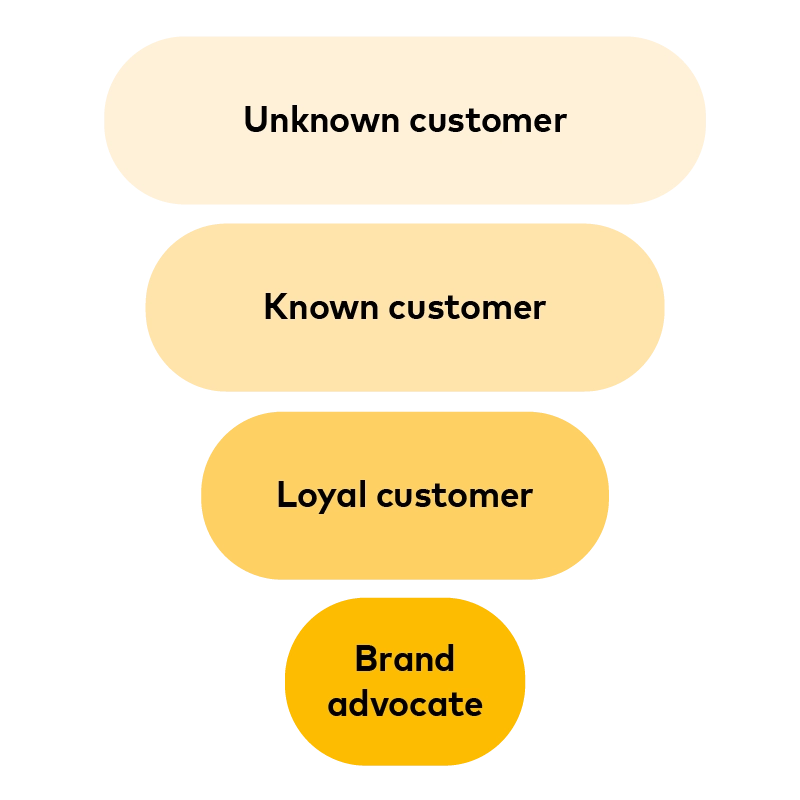By: Marissa Nolan
Published: July 26, 2022 | Updated: March 16, 2023
Read time: 7 minutes
When restaurant costs and competitive pressures increase, margins begin to shrink. To move from shrink to expansion, restaurants must connect with guests and provide an exceptional customer experience.
In this guide, we take a closer look at how using the latest technology, advanced analytics and innovative loyalty programs can help restaurants stay ahead of the competition.

En la actualidad, los restaurantes se enfrentan a un aumento de la inflación, a interrupciones en la cadena de suministros y a la escasez de personal, factores que aumentan los costos, afectan la frescura de la comida y reducen los beneficios. Además de estas macrotendencias, los restaurantes deben responder a las nuevas expectativas de los consumidores. Desde el inicio de la pandemia aumentó el apetito de los consumidores por los canales digitales de bajo contacto, como entregas sin contacto, recoger en la acera y los pedidos por móvil.
“Se calcula que entre el 30 % y el 40 % del cambio digital relacionado con Covid en la industria de los restaurantes será permanente.”1
Para mantenerse competitivos, los restaurantes deben poder entregar experiencias digitales óptimas y programas de fidelización atractivos que profundicen en las relaciones con los consumidores. Descargue la Guía de experiencia y compromiso del cliente para restaurantes para conocer estrategias innovadoras para conectarse con el consumidor después del Covid.
License plate recognition
Artificial intelligence is accelerating features like license plate recognition (LPR) technology, which can provide an even faster experience by recognizing customers before they have even ordered. For example, with appropriate permission, LPR can automatically recognize registered loyalty members, eliminating a frantic scramble for a loyalty card.
This technology could elevate personalization by customizing dynamic menu boards based on loyalty members’ profiles.
Voice ordering
Voice-ordering technology increases order accuracy and accelerates order fulfillment, whether through smart devices in the home or artificial intelligence in the drive-thru. Orders get to the kitchen in real time, so food preparation can begin immediately and staff can focus on preparing the food rather than taking orders.
Voice ordering can also allow restaurants to maintain output levels while minimizing labor costs.
Emerging payments
Consumers are now placing their orders through a variety of channels with particularly strong growth from mobile apps. Ninety percent of consumers are somewhat or very satisfied with mobile ordering and payment technology on personal devices, but only an average of 49% of restaurants deployed it, according to a global study.
Restaurants can improve the payment experience through biometrics, digital currencies, QR codes, contactless and card on file. Features such as two-factor authentication and facial recognition enhance the safety and security of these innovations and drive-up consumer trust as a result.
Web technologies
Website technologies offer a deeper understanding of today’s diners by shedding light on user interests, preferences and affinities. For example, with the right technology, restaurants can distinguish first-time visitors from return visitors who previously made a mobile purchase – and can see relevant contextual insights such as a purchase location or time.
Such technologies can transform websites into dynamic experiences that showcase personalized items, messages and offers. And with the use of A/B testing, these digital experiences can be optimized even further.
Transaction analytics
Advanced analytical tools can provide aggregated spending insights, like average ticket size and frequency, which can help enhance the customer experience through targeted item promotions based on spend behavior.
Additionally, such tools can help shed light on registered customers’ purchase decisions following a promotion, which can lead to more personalized offers. The results can help determine if and how a promotion should be rolled out.
Engaging customers with a best-in-class loyalty program
Loyalty programs can play a pivotal role in engaging consumers because they increase access to helpful consumer insights, which in turn enable restaurants to build stronger relationships with their patrons. Highly successful programs can even transform customers into brand advocates.
However, over 70% of restaurant decision-makers feel that their brand’s loyalty program lacks a modern digital interface, is difficult to use, is old and outdated and lacks the ability to deliver one-to-one personalized offers or experiences, according to a Forrester Consulting study conducted on behalf of Mastercard.
The following steps can enable restaurants to deliver a best-in-class loyalty program that engages customers.
Step 1: Refine the value proposition
Restaurants can develop a strong value proposition for their loyalty program by considering what registered customers can be rewarded for and how they will be rewarded. Many restaurant loyalty programs focus on rewarding customers solely for the amount they spend. That’s why rewarding for non-transactional activities, such as visit frequency or mobile app engagement, are powerful ways to differentiate a program.
Restaurants can recognize customers with traditional rewards, such as redeemable points or cash back, or use more innovative “surprise and delight” tactics to boost engagement and deepen consumers’ emotional connection to the brand. For example, the Starbucks Rewards program provides each member with a free food item or beverage to celebrate their birthday. Starbucks also used gamification in its “Prize & Delight” initiative, in which customers could play daily scratch ticket games for a chance to win prizes.
A strong value proposition will drive emotional loyalty by using the right balance of traditional and innovative tactics.
Step 2: Design a simple experience
Once restaurants have refined the overall value proposition of their loyalty program, they must bring it to life with an engaging experience. Although 59% of brands are focused on improving the customer experience, only 39% have seen improvements, according to a recent loyalty study by Forrester Consulting.
Consumers want frictionless experiences across channels – including a mobile app. Customers should be able to easily navigate the app, earn rewards and redeem their benefits. By creating convenient digital experiences through apps, SMS or other channels, brands can more successfully engage guests.
Not only do consumers want an easy experience, but many are looking for a fun experience too. Gamification can add a layer of fun by incorporating aspects of gaming such as completing a mission to earn points. Some restaurants reward customers for completing scavenger hunts, for example.
Step 3: Incentivize registration
Once the loyalty program has been developed, restaurants must appropriately incentivize registration by simplifying the process and clearly communicating the program’s perks. Restaurants should deploy A/B testing to determine how best to communicate the program’s value and to identify the right benefits to highlight based on customer profiles.
By registering loyalty members and obtaining their informed consent, restaurants can develop a deep and dynamic understanding of their customers and provide a more personalized experience as a result.
Step 4: Understand the customer
Customers are more inclined to stay with a brand when they feel that their needs and preferences are understood.
To develop a 360-degree view of the customer, brands should collect relevant first-party data — such as customer feedback — and external, third-party data — such as broader consumer spending trends. Loyalty program data is a critical component as well.
When a customer signs up for a loyalty program and provides consent, the restaurant can then leverage their purchase history, such as past orders, along with their non-purchase information, such as app engagement, to drive smarter and more targeted communications.
Step 5: Personalize promotions
Consumers want a personalized experience across channels – and within that experience, they especially want to see personalized promotions. To stay competitive, restaurants must be able to deliver the right offer, at the right time, through the right channel. By using the 360-degree view of a customer captured from a loyalty program, restaurants can create dynamic segmentations and successfully deliver personalized offers that incrementally motivate spending activity.
By using data-driven insights to carefully craft promotions, restaurants can avoid “trade down” offers – offers to customers who would have transacted regardless. To efficiently deliver their promotions, restaurants can use technologies that enable scheduled and customer-decision-triggered communications across email, push, SMS and digital channels.
Once a promotion has been delivered, restaurants should measure the impact in terms of units sold, price and average check size. The promotion should be evaluated over time to identify optimization opportunities.
Loyalty programs can turn customers into brand advocates

Unknown Customer: These customers are unknown due to reasons such as paying in cash.
Known Customer: Although these customers are not registered in the loyalty program, restaurants know who they are because they use a consistent identifier, such as the same credit card.
Loyal Customer: These customers have registered for the restaurant’s loyalty program.
Brand Advocate: This segment includes loyal customers who assist in brand advocacy through positive, organic word of mouth.
Conclusion
With more competition and rising costs, restaurants are at a critical moment. Cutting-edge technology, robust analytics and engaging loyalty programs can enhance the experience for consumers, improve speed and efficiency within the restaurant and ensure that diners return.
Mastercard works with restaurants to develop the right strategies for serving up the best experiences for their guests. To learn more, request a demo.








